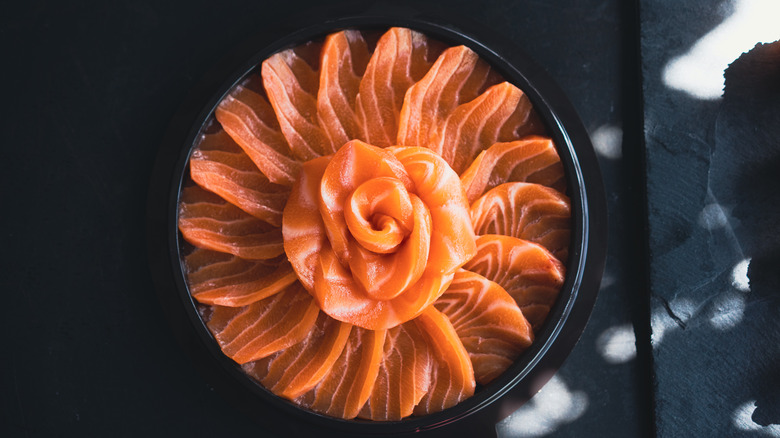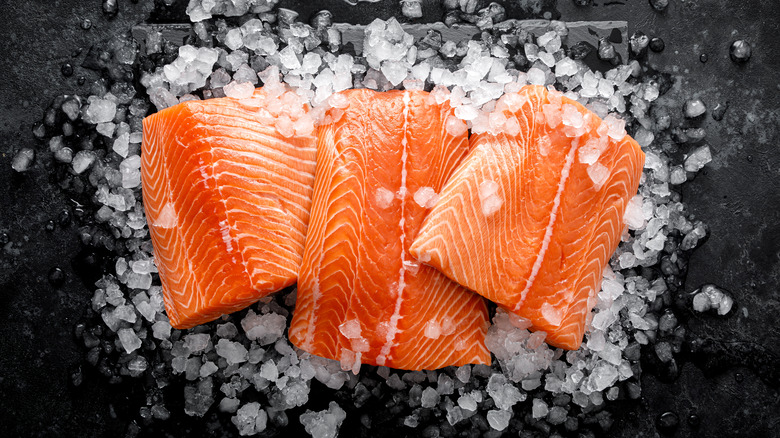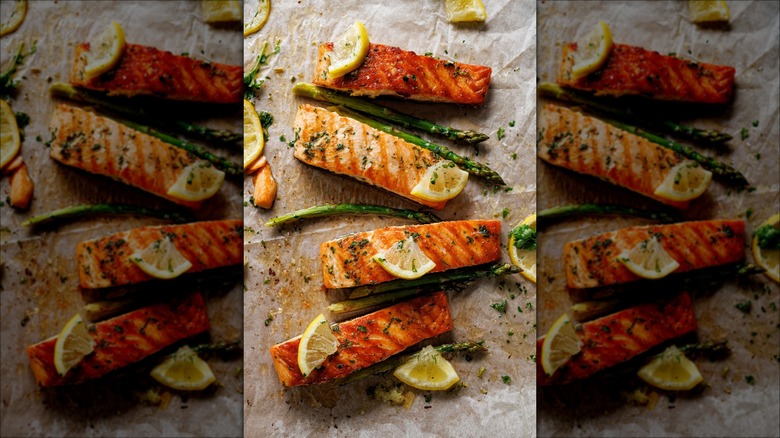Why It's So Important To Deal With The Pin Bones In Your Salmon
When it comes to fish, there are countless choices for what can be the hero in your homecooked meal, with tasty options ranging from tuna to cod, from tilapia to catfish, and so many, many more. However, all of these fish arguably take the backseat when it comes to salmon. According to National Geographic, salmon is the most popular type of fish in the U.S., with Americans consuming 450,000 tons of it yearly. It's unsurprising, as salmon is beloved for its versatility. There are a number of different ways to cook fish, including pan-roasting, oven-baking, grilling, or even eating it in its raw form. Needless to say, this makes it a bit difficult to get bored of the fish!
Salmon also provides a number of health benefits. According to Healthline, it is rich in omega-3 fatty acids that aid in several functions, including reducing inflammation and decreasing cancer risk. Salmon is also loaded with protein, which assists with functions like healing the body and weight management.
Unfortunately, salmon isn't without its faults. A common problem with salmon is pin bones. Technically, pin bones are actually not bones at all; they're calcified nerve endings found throughout a salmon filet, per the Alaskan Salmon Company. Nevertheless, these nerve endings feel like bones and can ruin a filet if not dealt with properly.
Pin bones are a choking hazard
Though it seems a bit unusual, pin bones are actually edible, according to the Alaskan Salmon Company. Like salmon, they're nutrient-rich and healthy for you. However, eating pin bones does come with risks. If you choose to leave them in your salmon filet, one could easily become stuck in your throat, causing you to choke. According to Healthline, there are some actions you can take if you get a pin bone stuck in your throat, such as swallowing one to two tablespoons of olive oil or taking a bite of a banana.
That being said, it's probably best just to avoid the risk of choking on pin bones altogether by removing them from your salmon filet. There's a quick and easy method for this — all you'll need is a pair of tweezers or pliers. Per the Wild Alaskan Company, the first step in pin bone removal is locating the pin bones. You can do this by pressing down on the salmon filet, causing the pin bones to stick up. After finding the pin bones, simply use pliers or tweezers to pull them from the filet. Do not pull the pin bones in an upward or opposite direction, as this can damage your filet and make it look less appealing.
Ways to take your salmon to the next level
One of the easiest ways you can take your salmon to the next level is by being prepared before you cook it. According to the New York Times, this involves buying the necessary cooking tools and instruments (such as a large spatula for flipping the salmon), determining if you want wild-caught or farmed salmon, and determining how you will cook the salmon. Before you begin working on your dish, will you poach, sear, roast, grill, or perhaps go some other route? Knowing your method of cooking plays an important role in making your salmon its best. For example, if you plan to grill your salmon, there are an entire set of grilling tips you should know.
Another great way to highlight your salmon's flavor is to add a sauce, per the Alaskan Salmon Company. While sauce options are countless, you can't go wrong with a classic lemon herb sauce. You could also add a glaze to your salmon; if you're looking for delicious, strong flavors, try a whiskey and ginger glaze. Whichever way you choose to make your salmon, make sure you're mindful of the pin bones, as these can put a damper on a beautiful salmon dish.


